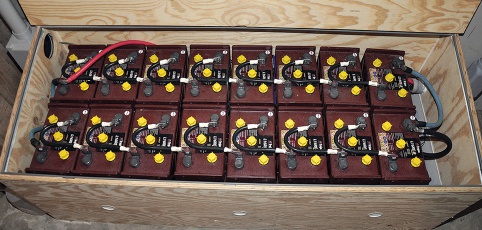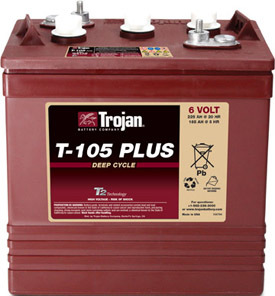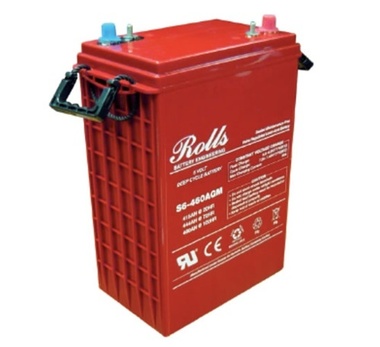 Loading... Please wait...
Loading... Please wait...Products
- DC Appliances
- Solar Refrigerators and Freezers
- Solar Panel Kits
- Solar Panels
- Solar Generators
- Inverters
- Inverter Monitoring
- Inverter Accessories
- Balance of Systems
- Racking and Mounting
- Rails
- Flashings
- Splice Kits
- Stopper Sleeves
- Conduit Mounts
- Attachments
- Brace Assembly
- Base Mount
- Brackets
- Bolts
- Clamps
- Caps
- L-Feet
- Washers
- Skirt
- Lugs
- Tilt Legs
- Hooks
- Stand-Offs
- Ballast Bay
- Top of Pole Mount
- Side of Pole Mount
- Flush Mount Kits
- Ground Mount Kits
- Roof Mount Kits
- Hardware Packages
- Wire Management
- Batteries
- Battery Accessories
- Charge Controllers
- Tools and Supplies
- View All Products
Solaris Blog - Size Solar Battery Bank
How to Size a Solar Battery Bank
Posted by Brandi Casey on 11th Jan 2017

*Two Phase Trojan Battery Bank
When installing an off-grid or hybrid PV array, sizing the battery bank can be a complicated process, and oftentimes, research leads to more questions than answers. There are multiple specifications to a battery and the meanings of these terms and ratings can lead to college calculus flashbacks. Luckily, there is a way to determine the size of battery you should be selecting for your solar system.
The first step is to determine the size of your solar array,
this can be easily determined by collecting 6 months to one year of your utility
bills, and calculating your average kilowatt hours.
Example:
01-16: 2350 kWh
02-16: 1750 kWh
03-16: 1550 kWh
04-16: 1725 kWh
05-16: 3250 kWh
06-16: 2750 kWh
Total – 13,375 kWh
13,375 kWh/6 months = Average 2,229.68kwh or 2.3kWh
The next step is determining what voltage system you will want. This voltage is often determined by the overall voltage of your solar panels. Typically, for a solar set up, a 12-volt system is the most desirable. For the purposes of determining the remaining calculations, we will use a 12-volt set-up.
For Amp Hour ratings, most PV compatible batteries use a C20 rating. The C20 rating means that the battery has been completely discharged over a period of 20 hours. There are also C100 ratings that mean the battery has been completely discharged over a period of 100 hours. Typically, when looking at solar retailer sites, the rated Amp hours listed in the product title is the C20 rating typical for the industry.
To determine the kwh usage of a battery, you simply need to multiply the Amp Hour (Ah) rating by your desired voltage system.
One-Phase Battery Bank System
225Ah @ 12 Volts = 3.3 kWh at 100% discharge = 2 Batteries
225Ah @24 Volts = 6.6 kWh at 100% discharge = 4 Batteries
225Ah @48 Volts = 13.2 kWh at 100% discharge = 8 Batteries
Two-Phase System (Double the Ah)
550Ah @12 Volts = 6.6 kWh at 100% discharge = 4 Batteries
550Ah @24 Volts = 13.2 kWh at 100% discharge = 8 Batteries
550 Ah @48 Volts = 26.4 kWh at 100% = 16 Batteries
To meet the requirements set by the previously mentioned average kWh the best battery bank size would be the 225Ah @ 12 Volt system with 2 batteries. Over sizing the battery bank will result in much better performance. Furthermore, the slower batteries are discharged, the more storage capacity they will have.
For beginners, we recommend the manufacturers Trojan Battery and Surrette Rolls.

*Trojan T105 AGM Battery
The above calculation was based on the Trojan T105 batteries, which are very popular for larger battery banks due to the paralleling capability. With proper maintenance, these batteries can last 4-6 years, and 1-2 years with improper maintenance. It is important to obtain the owner’s manual and maintenance guide for any battery you purchase to take advantage of the longest possible lifetime.
Another popular beginner battery from Trojan is the L16 which has 60% more capacity, higher lead and electrolytes than the T105, which makes them last longer. However, this increased size does increase the cost of the batteries.
Surrette Rolls are typically more expensive than Trojan Batteries, and at times can be difficult to obtain as they do not have the distribution power of Trojan Battery. However, they provide a 7-year warranty which is 2 years more than the typical Trojan Battery warranty. Both manufacturers produce high end batteries that will complete any solar system, and selection between the two comes down to a matter of preference and budget.

*Surrette S460 AGM Battery
A good starting battery from Surrette is the S460 model which was specifically designed for solar. With proper maintenance, this battery can maintain your system well past its warranty period.
The S530 model is stronger than the L16 model from Trojan, and contains more lead and capacity. However, this increased capacity is reflected in the overall cost.
Although sizing a battery bank is difficult, it can be very rewarding for those who want to store energy at night or be completely detached from the grid. For questions or help sizing your battery bank, you can contact a Solaris Technician and we will be happy to assist you.



